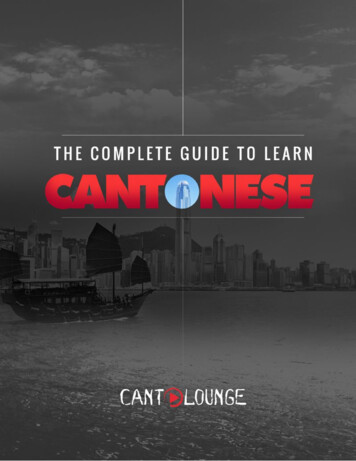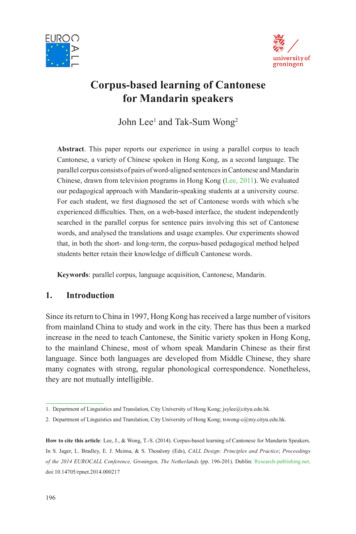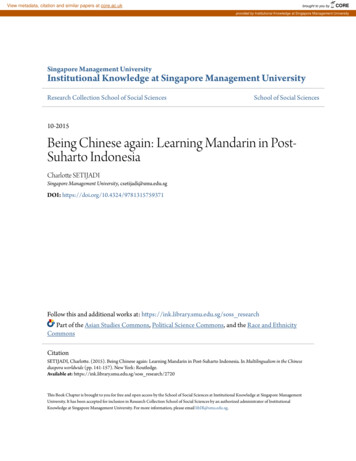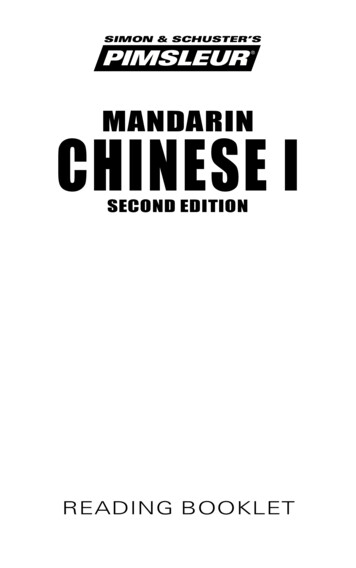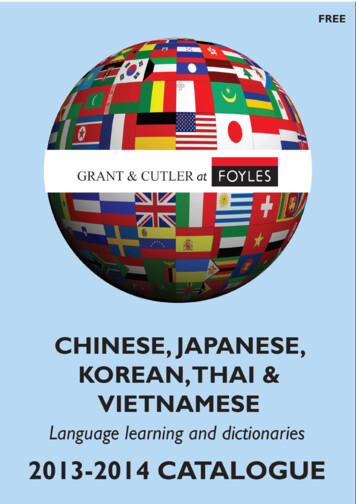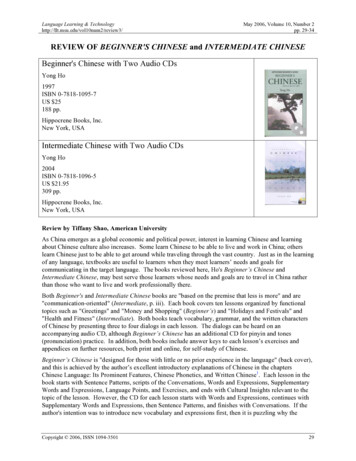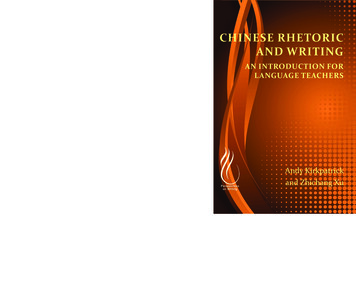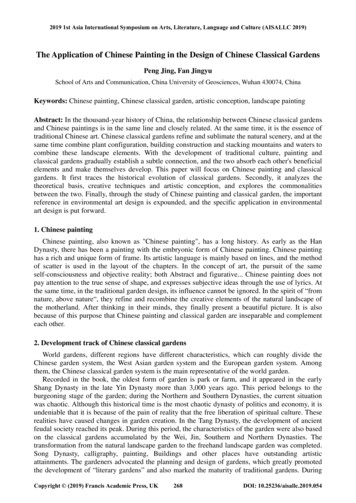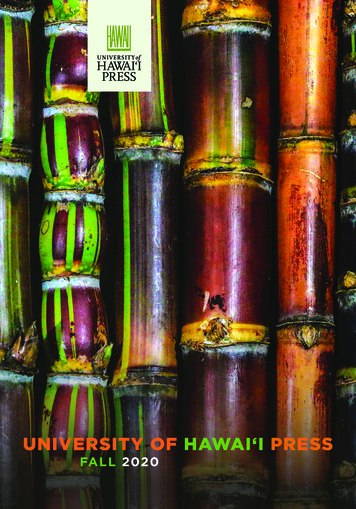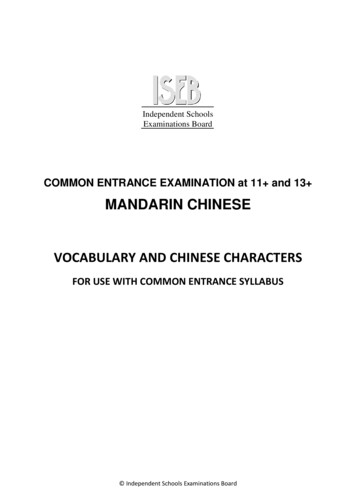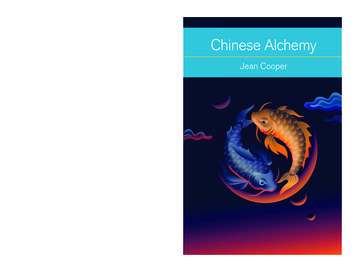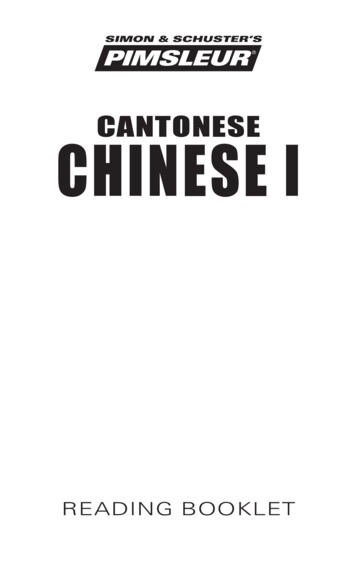
Transcription
SIMON & SCHUSTER’SPIMSLEUR cantonesechinese Ireading booklet
Travelers should always check with theirnation's State Department for currentadvisories on local conditions beforetraveling abroad.Graphic Design: Maia Kennedy and ‰ Recorded Program 1999 Simon & Schuster, Inc. Reading Booklet 1999 Simon & Schuster, Inc.Pimsleur is an imprint of Simon & Schuster Audio,a division of Simon & Schuster, Inc. Mfg. in USA.All rights reserved.
acknowledgmentsCantoneseVoicesEnglish-Speaking Instructor . . . . . . . . . Ray BrownCantonese-Speaking Instructor . . Man Him M. LukFemale Cantonese Speaker . . . . . . . Mei Ling DiepMale Cantonese Speaker . . . . . . . . . . . . Patrick LoCourse WritersChristopher Gainty Hua LinEditorsKimiko Ise Abramoff Beverly D. HeinleCantonese ConsultantMei Ling DiepExecutive ProducerBeverly D. HeinleProducer & DirectorSarah H. McInnisRecording EngineersPeter S. Turpin Kelly SauxSimon & Schuster Studios, Concord, MAiii
For more information, call1-800-831-5497 or visit us atwww.Pimsleur.com
table of contentsNotes on Cantonese Language and CultureThe Cantonese Language . . . . . . . . . . . . . . . . .Tonality . . . . . . . . . . . . . . . . . . . . . . . . . . . . . . .Traditional Language Beliefs . . . . . . . . . . . . . .About Drinking . . . . . . . . . . . . . . . . . . . . . . . . .Chinese Names . . . . . . . . . . . . . . . . . . . . . . . . .Dim Sum and Tea Houses . . . . . . . . . . . . . . . . .Cantonese and English . . . . . . . . . . . . . . . . . . .The Concept of Min . . . . . . . . . . . . . . . . . . . . . .Compliments . . . . . . . . . . . . . . . . . . . . . . . . . . .Rice and Meals . . . . . . . . . . . . . . . . . . . . . . . . .The Chinese Zodiac . . . . . . . . . . . . . . . . . . . . . .Hospitality . . . . . . . . . . . . . . . . . . . . . . . . . . . . .Chinese Festivals . . . . . . . . . . . . . . . . . . . . . . . .The Chinese Calendar . . . . . . . . . . . . . . . . . . . .Written Chinese . . . . . . . . . . . . . . . . . . . . . . . . .v168111315161820212225273133
cantoneseThe Cantonese LanguageAlthough Mandarin Chinese is the statelanguage of China, used by the government and inthe schools, there is no one “Chinese” language.Due to the size of China and the ethnic diversity ofits population, hundreds of dialects are spoken indifferent areas. These are the languages used forday-to-day communication between friends, family,and neighbors.Of these, Cantonese is one of the most widelyspoken, both in China and in Chinese communitiesaround the world. Cantonese is a member of theYue group of dialects of the Sino-Tibetan languagefamily originating in southern China. It was firstspoken in the province of Guangdong, northwestof Vietnam, along the coastline of the Yellow Sea.The city of Guangzhou, capital of Guang-dong,called “Canton” by the British, is historically thehome of Cantonese.The island territory of Hong Kong, a Britishcolony until 1997, lies just offshore, not far fromGuangzhou. It is, therefore, not surprising thateven in the commercial center that is modern HongKong, the Chinese spoken by the overwhelmingmajority is Cantonese, called Guongdung wa,or “dialect of Guangdong.” Due to Hong Kong’s
cantoneseThe Cantonese Language (continued)importance as a financial and commercial center,Cantonese has gained importance as a languageof trade, although most business on the island isconducted in English.Cantonese is also the dialect spoken by themajority of Chinese expatriates, especially in suchplaces as Vietnam, Singapore, and Macao, as wellas in the United States.The proximity of the cities of Guangzhou andHong Kong has meant that the Cantonese languagespoken in each is basically the same in structure. Theethnic Chinese population in Hong Kong originatesmostly from the neighboring Guangdong province,and so it is not surprising that the dialect used in HongKong has its roots in Guangzhou Cantonese.The Cantonese spoken in Hong Kong andGuangzhou are mutually understandable, althoughsmall differences do exist. Due to differing historyand influence, there are now some minor differencesbetween the Cantonese spoken in Hong Kong andGuangzhou Cantonese. There are some, althoughnot many, differences in pronunciation. The term“yesterday,” for example, is pronounced kem yedin Hong Kong, beginning with a “k(uh)” sound.2
cantoneseThe Cantonese Language (continued)However, a speaker from Guangzhou is more likelyto say cem yed. For the most part, differences inpronunciation are minor, and speakers from the twoareas have no difficulty understanding each other.It is the Hong Kong dialect which is taught andpracticed in this course.The main difference between the two dialectsof Cantonese lies in the languages which haveinfluenced each dialect. The Cantonese spokenin Guangzhou has been more directly affectedby the Mandarin Chinese taught in schools andused by the government. The cosmopolitan natureof the city of Hong Kong — a British colony fornearly one hundred years — has had a significanteffect on the Cantonese spoken in that city. HongKong Cantonese has borrowed many words fromother languages, but the loan-words are primarilyfrom English.The Chinese government has historicallydiscouraged the use of Cantonese (as it has otherdialects of Chinese), requiring that schools teachonly Mandarin Chinese, the official state language,which is used in Beijing, the Chinese capital.However, even in mainland China some 70 millionspeakers use Cantonese at home and among friends3
cantoneseThe Cantonese Language (continued)and neighbors. Overseas, there are several millionmore speakers of Cantonese.The English name, “Cantonese,” comes from“Canton,” the old Western name used to refer toboth the province of Guangdong and its capital city,Guangzhou. In Cantonese, however, the languageis known as Guongdung wa, or “Guangdongdialect.” Some speakers may also refer to it asGuongzeo wa, but this is less common in themodern era, especially in Hong Kong.These names use the word wa or “dialect.”Despite the many differences in vocabulary andgrammatical structure, Cantonese speakers seetheir language as a part of the Chinese familyof languages. This is in contrast to the name ofthe English language: Yingmen, or “language ofEngland,” with the men ending meaning “language.”However, to refer to Mandarin Chinese, theword used for “language” is yü. In Cantonese,Mandarin Chinese is known as guog yü —“national language.” The difference between thetwo words for “language” used to say “English”and “Mandarin Chinese” is that the men endingis used to refer to spoken AND written language,4
cantoneseThe Cantonese Language (continued)while yü only refers to a spoken language. Thisreflects the fact that Mandarin was originally nomore than one of many spoken Chinese languagesand dialects. However, as it is the only Chineselanguage which can be entirely represented usingthe standard characters, and as it’s spoken inBeijing, the Chinese capital, it was recognized asthe official language in the 1950s.Cantonese, on the other hand, is differentenough from Mandarin that not all Cantonesewords and particles can be represented usingthe standard characters. Several “Cantonese”characters are sometimes added to fill this need, butfor the most part, Cantonese does not appear as aseparate written language. A simplified Cantoneseis sometimes represented in characters, but usuallyonly in comic strips or on some storefront signs.5
cantoneseTonalityChinese is a “tonal” language. This meansthat in addition to the sounds of the consonantsand vowels, the tone with which a syllable ispronounced helps to determine its meaning. Thevarious Chinese dialects are almost exclusivelymade up of one-syllable words, composed of aninitial consonant sound followed by the syllable’smain vowel, sometimes in combination withanother consonant or vowel. Longer words doexist, but almost all are compound words, formedby combining one-syllable words.Because there are a limited number of possiblecombinations within a single syllable, in order toexpress a greater variety of meaning, Cantonesealso takes into account the tone with which asyllable is pronounced. The tone is determined bythe pronunciation of the syllable’s main vowel.Each tone has a name which describes the startingpoint — “high,” “mid-level,” and “low” — and thefalling, rising, or level motion. In this way, severalmeanings can be assigned to any one syllable,depending on the tone with which it is pronounced.For example, when pronounced using a high leveltone, the word xig means “can,” in the sense of “amable to, know how to.” However, when this word ispronounced with a low level tone, it means “to eat.”6
cantoneseTonality (continued)Linguists disagree on the number of tones usedin speaking Cantonese. Some count nine tones,based on length, six of regular length and threefor so-called “short syllables.” Some count seventones, adding a disputed “high falling” tone. Butthere is general agreement on the basic six tones:high level, mid-rising, mid-level, mid-falling, lowrising, and low level. This course introduces thesesix tones, which are as follows:1st tone: (high level)xi (poem)2nd tone: (mid-rising)xi (history)3rd tone: (mid-level)xi (attempt)4th tone: (mid-falling)xi (matter)5th tone: (low rising)xi (market)6th tone: (low level)xi (time)7
cantoneseTraditional Language BeliefsJust as the number thirteen is traditionallyregarded as unlucky in the West, the Cantonesenumber four, séi, is seen as ominous, because itis very similar to the word for “death.” The onlydifference in this case is that “four” is pronouncedwith a mid-level tone. The word, pronounced witha mid-rising tone, means “death.”Conversely, the number eight, bad, is regardedas lucky, since it sounds very much like the wordmeaning “to prosper” — fat. Other numbersconsidered lucky are the “mathematical” form of“two,” yi, as this is the same as the word meaning“easy.” Here the only difference is in context,as both are pronounced using a mid-level tone.Similarly “three,” sam, is another number thoughtto bring good luck, as it sounds like the wordmeaning “to produce” or “to be alive” — sang.You’ve heard this word in the title, xinsang. Thisliterally means, “earlier produced” or “first born,”reflecting the Cantonese respect for age.The number nine, geo, carries a positivemeaning, as this word sounds exactly like theCantonese word meaning, “long-lasting.” Thesetwo words are represented in writing by two8
cantoneseTraditional Language Beliefs (continued)different characters, but when spoken the distinction is made only through context.The number nine is used in the city name“Kowloon” — geo lung, or literally, “nine dragons.”In China, the dragon is a symbol of royalty andgood fortune. This number is also traditionally usedwhen setting a woman’s dowry. In contemporaryChina, this price is largely symbolic, and thereforethe amount chosen is significant not for its size,but for the numbers used to describe it. For thatreason, the price will be set, for example, at“ninety-nine dollars” rather than “one hundred,” asthe repetition of this number is thought to ensurelongevity in the marriage.That’s when geo is spoken with a mid-risingtone. Spoken with a mid-level tone, geo means“rescue” in Cantonese. When reporting a fire,accident, or other emergency in Hong Kong, aperson would dial “nine — nine — nine.”These associations are also considered relevantwhen the numbers appear in combination. Forexample, when the numbers “two” and “eight” arepronounced in that order, yi bad, they can have themeaning “prosper easily.” Similarly, when “two” is9
cantoneseTraditional Language Beliefs (continued)followed by “three,” yi sam, the meaning “produceeasily” can be inferred. However, combinations of“two” and “four” are to be avoided, as these twonumbers in combination could be interpreted as“die easily.” Of course, these traditional beliefs donot carry the same weight as they once did, but theyare still reflected in customary usage.10
cantoneseAbout DrinkingIn this course, you have used the word zeowhen asking for “wine.” Literally, however, thisword means “alcohol,” and it’s used as a generalway to refer to all alcoholic drinks, including beerand spirits. Therefore, to specify a certain type ofalcoholic drink in Cantonese, you must either referto it by name or add some sort of description. Ngosêng yem yeddi zeo, simply means, “I want to havea drink.” To specify “wine,” you must ask either for“grape alcohol” — po to zeo — or for rice alcohol— mei zeo. The word you used for “beer,” bézeo,literally means “barley alcohol.”There are many idioms associated with thephrase yem zeo, most having to do with theobservance of some holiday or milestone in aperson’s life, such as a wedding, birthday, or thebirth of a child. For example, Ngo gem man hêuyem, literally means, “I’m going to have a drinktonight,” but it can imply “I am going to attenda reception or banquet, or some other functiontonight.” While this phrase is usually used todescribe a wedding banquet, it can also refer toother occasions. However, the question, Néi géixi céng yem? (“When will you invite people todrink?”) always refers to a celebration given for a11
cantoneseAbout Drinking (continued)newly-married couple. It’s like asking, “When areyou going to hold your wedding reception,” that is,“getting married?”Here are some other uses of the word zeo:zeo ga — “tavern”zeo leo — “restaurant,”(or literally, “alcohol building”)zeo dim — “hotel”zeo pou — “liquor store”12
cantoneseChinese NamesAs in many other Asian cultures, in China thesociety or group is valued more highly than theindividual. Your importance is measured by yourvalue to the group, rather than by those qualitieswhich distinguish you from others.This can be seen in the way a person is namedin Cantonese. The most important element of theperson’s name is thought to be the family of whichhe or she is a member, and so the family name isspoken first. The given name, which sets the personapart even from others with the same family name,is the final element. Take, for example, the nameCen Xin Hung. Cen is the family name and XinHung the given name.The given name, or first name, is represented byeither one or two one-syllable characters. A child’sgiven name is usually chosen very carefully, torepresent the parents’ hopes for and expectations ofthe child. Cantonese children are not usually giventhe name of a relative.Westerners are usually referred to by a phoneticrepresentation of their names, and a few Westernnames have been adopted by some Hong Kongparents. Among these are the names “David” 13
cantoneseChinese Names (continued)dai wei ; “Mary” - ma léi ; and “Charlie” - ca léi.The actor Charlie Chaplin, popular in Hong Kong,is known as ca léi coek bit ling. Chinese peoplewith a “Western” name will often have a traditionalChinese one also.There are actually over one thousand Chinesefamily names in use, but only a few dozen are verycommon. Children usually take their fathers’ lastnames; occasionally the mother’s last name mayalso be used. Most last names are written usingsingle characters. There are a few two-characterlast names in use: among these, Seeto and Auyeungare two of the most common. Given names areusually made up of one character on the mainland,and two in Hong Kong.14
cantoneseDim Sum and Tea HousesMany Americans are familiar with the term dimsum. This literally means “tease your heart,” and inChina it is used to refer to small pastries and otherfinger foods served with tea.In earlier days, dim sum was eaten as a breakfastor light brunch in the morning. Now, however, itis served in tea houses until two or three o’clock inthe afternoon.This custom is observed all over China, not onlyin areas where Cantonese is spoken. The term dimsum is the same in both Cantonese and MandarinChinese. However, in Mandarin this refers only toappetizers, while the Cantonese sometimes make alight meal of dim sum.Chinese people will often have their dim sum ina tea house. This is a small establishment whichcombines the functions of a café and a restaurant.The tea house is often used as a neighborhoodreference point, a place where receptions orbanquets are held or where one might conduct aninformal meeting with business partners or friends.15
cantoneseCantonese and EnglishHong Kong was a British colony for over onehundred years, and Guangzhou was one of the firstfive cities to be opened to Western traders at theend of the 19th century. Consequently, Cantonesebecame the most “Westernized” dialect in Chinese.Many Cantonese speakers in Hong Kong useEnglish loan-words in their everyday conversation.Some may do so to show off their English ability,but in most cases, the words are so widely usedin Cantonese that people are hardly aware of theirEnglish origins. Here are some examples:bo - means “ball”baxi - means “bus”boxi - means “boss”lip - means “lift”soetsam - means “shirt”xidam - means “stamp”tipxi - means “tips”xido - means “store”Cantonese words don’t usually end with a finalconsonant sound, so foreign words such as “ball”or “bus” are often pronounced either with a glottalstop at the end or an added vowel sound.You may hear a Hong Kong policeman addressedas “Sir!” — ah soe. “Soe” is the Cantonese pronunciation of the English word, “sir” and the “ah”16
cantoneseCantonese and English (continued)beginning is used to draw the person’s attention. Itsets a friendly, yet respectful tone for the conversation. But this way of saying “sir” is used only toaddress policemen, or less frequently, educators.The Cantonese word xinsang is used otherwise.17
cantoneseThe Concept of MinLanguage is a vibrant, flexible form ofcommunication loaded with social and culturalinformation.Cantonese culture is structuredaround such values as honor, loyalty, and respect.In fact, the respect with which a person’s communityregards him or her can serve as an important partof that person’s identity. In Cantonese, this is oftenreferred to as min, which is somewhat equivalentto “face.” Here are some common phrases:Yeo min — “to have face” — means to be shownrespect in a certain social situation. For example,when attending a banquet, those seated near thehost at the head of the table can be said to yeo min.Similarly, bei min — “to give face” — means toshow someone the respect due him or her. Whenyou attend a formal dinner, the host and hostessmight greet you by saying, dozé bei min. Thisliterally means, “Thank you for giving face.” Inthis situation, it is equivalent to saying, “Thank youfor coming.”Lok min — “to drop the face” — means toshame a person, to cause him or her to lose therespect of others. A person thought to be an expert18
cantoneseThe Concept of Min (continued)on a certain topic can be said to lok min if he or sheis corrected in public.Mou min — “to lack face” — means to losedignity. For example, you are thought to lose faceif you are the only one of a certain group who ispassed over for a promotion or who fails to receivean invitation to a sought-after event.19
cantoneseComplimentsModesty is seen as an essential virtue inCantonese culture. This humility is shown by sometypical responses a Cantonese person will givewhen complimented. For example, a woman whois told Néi zen hei hou léng (“You are really verybeautiful”) could answer, Bindou hei a? As youmay be able to guess, this literally means, “Where isit?” Used this way, it is like saying, “Where do youget that?” or, “I don’t know what you’re saying.”Another common response to a complimentmight be, Guo zêng la! This means something like,“Excessive praise!” and it’s used to say, “You’reexaggerating,” or “You’re too kind.” Either of thesecan be used as a polite, modest response to almostany compliment. Some more Westernized peoplemay also answer simply, Dozé when complimented,but this is less common.20
cantoneseRice and MealsIn this course, you have used the phrase xig manfan with the meaning, “eat supper.” Fan literallymeans “cooked rice,” but in modern Cantonese, thisword has come to mean “meal.” In the traditionallyagricultural society of Southern China, andespecially in the areas where Cantonese is spoken,rice has long been a staple. Even now, rice makesup roughly one third of the local diet.The importance of rice is reflected in someCantonese idioms. In colloquial speech, theterm “rice bowl,” fan wun, refers to a person’soccupation, that is, the source of the money neededto put rice in the bowl. Likewise, the term “ironrice bowl,” tit fan wan, is used to refer to secureemployment, or a position which provides a reliablesource of income. However, the term, “rice barrel,”fan tung, is used in a derogatory sense, to refer to aperson who consumes excessively without givingback to the family or community through his orher work.21
cantoneseThe Chinese ZodiacThe Chinese have a system of astrology datingback thousands of years. The Chinese zodiacdiffers from the Western in that each sign representsan entire year, rather than one month.According to traditional Chinese legend, agesago, Buddha summoned all of the animals. Hehonored those who came by naming a year for them.Each animal in turn then gave its characteristicsto people born in its year. The twelve-year cycleruns as follows:Year of the Rat — xüYear of the Ox — ngeoYear of the Tiger — fuYear of the Rabbit — touYear of the Dragon — lungYear of the Snake — séYear of the Horse — maYear of the Ram — yeungYear of the Monkey — heoYear of the Rooster — geiYear of the Dog — geoYear of the Pig — ju22
cantoneseThe Chinese Zodiac (continued)Here is the list of qualities traditionally associated with each animal symbol. The cycle begins with the Year of the Rat.Anyone born during the Year of the Rat is expectedto be honest and generous, possessing both greatambition and remarkable self-control. Recent Yearsof the Rat have been 1936, 1948, 1960, 1972, 1984,and 1996. The next one will be in 2008. The Year of the Ox follows. Someone bornduring an Ox year is both intelligent and perceptive,patient with others, but scornful of failure. A person born in the Year of the Tiger istraditionally expected to be aggressive and shorttempered, albeit courageous and considerateof others. If a person is born in the Year of the Rabbit,it is believed that he or she will be affectionate andskillful, successful in the business world despitebeing shy. A person born in the Year of the Dragon isexpected to be both stubborn and empathetic and topossess a great deal of energy.23
cantoneseThe Chinese Zodiac (continued) Someone born in the Year of the Snake iswise and beautiful, yet possibly vain and possessedof a quick temper. If you were born in the Year of the Horse, youwill be attractive, amiable, and well-liked by others. Someone born in the Year of the Ramwill be gracious and creative, but be relativelyuncomfortable in a leadership role. A person born in the Year of the Monkey isclever to the point of genius, with a gift for detail. A Rooster is a self-directed, hard-workingloner, who prefers to choose his or her own agenda. Someone born in the Year of the Dog is loyaland honest, although demanding of those aroundhim or her. A person born in the Year of the Pig isexpected to be noble and well-mannered, with greatintegrity and a few close friends.24
cantoneseHospitalityDuring your travels abroad, you may findyourself invited to dinner in a Chinese home. Hereare some customs which relate to hospitality andcorrect behavior as a dinner guest.As in the West, it’s considered rude to begineating immediately when served. Rather, youshould wait until everyone has been seated andall of the dishes have been served. Once this hasbeen done, it’s customary for the host or hostess tosay, “Eat rice!” — xig fan. This is similar to suchAmerican expressions as, “Dig in!” or, “Enjoyyour meal.” After the host or hostess has greetedthe guests in this way, they in turn may address oneanother using the same phrase. Xig fan having beensaid all around, everyone begins to eat.At a more formal dinner party, you may hear thehost and hostess greet the guests with the longer, morepolite phrase gog wei héi fai, which means, “Ladiesand gentlemen, please raise your chopsticks.”At this kind of occasion, a toast is frequentlyoffered before the food is served. The personoffering the toast could say, yem bui or literally,“drink a cup.” Another common toast is zuk néi ginhong, meaning, “I wish you health.”25
cantoneseHospitality (continued)When serving yourself during dinner, you willneed to remember to serve yourself only thoseportions nearest you at the edge of the plate. It’sconsidered rude to stir the food in any dish. Ifyou have finished while others are still eating,you should say man man xig (“slowly slowly eat”)meaning, “Take your time, enjoy your dinner.”After this you may leave the table.When you are leaving the home of your host andhostess, they may say to you, Man man hang! Thisliterally means, “Slowly slowly walk!” and in thissituation, it’s like saying, “Safe trip home!”26
cantoneseChinese FestivalsUntil the fall of the Chinese Empire in 1911,the Chinese measured the passage of days, months,and years using a lunar calendar. Developedthousands of years ago, this calendar used thedifferent phases of the moon as a reference point.The lunar calendar is also called “agriculturecalendar,” which is based on the seasons, tellingpeasants when to spread the seeds of certain crops,when to get in the harvests, etc.Although modern Chinese now follow thecommonly accepted Western calendar, the older,lunar system is still in use as a means of determining the dates of traditional holidays.Of these, perhaps best known in the West is thetraditional New Year’s celebration which is themost important annual festival in Cantoneselife. Due to the differences between the Chineseand Western calendars, the Chinese New Yearusually occurs somewhere between January 21and February 19. Despite the date, this holidayis known in Cantonese as the “Spring Festival,”Coen Zi, as it’s thought to be the day when theweather begins to change. However, when it iscelebrated, it is often the coldest time of the year!27
cantoneseChinese Festivals (continued)When celebrating the Chinese New Year,Cantonese people will often exchange traditionalgreetings. These vary, but all express the wish thatthe person with whom you are speaking will havegood luck in the New Year. For example, whengreeting an older person, you might say, Gung héinéi cêng méng bag sêu. This literally means, “I wishthat you may live one hundred years.” Similarly,you could greet a child by saying, Gung hei nei faigou zêng dai, or, “I wish that you may grow fastand tall.” To a young couple, you could say, Gunghéi néi déi med wen sing gung. Saying this, you arewishing them good fortune and a happy marriage.Other common greetings, applicable to anyone,are Gung héi fat coi (“May you receive a fortune”)and Man xi yü yi (“Ten thousand things will turnout according to your wishes.”)The purpose of these greetings is to establishan atmosphere of good luck as the year begins.Conversely, anything associated with bad luck isavoided in conversation at all costs. During theholiday, the Chinese refrain from discussing death,séi; illness, béng; or loss, xü. You should nevergive someone a book as a New Year’s gift, because“book,” xü, has the same sound as the word “loss,”28
cantoneseChinese Festivals (continued)or “to lose.” Similarly, a clock is an inappropriategift, because the phrase “give clock,” sung zung,sounds very similar to the words meaning, “attendsomeone’s funeral.”The Chinese will even try to avoid expressingdisappointment or displeasure of any kind duringthis holiday. If, for example, you inadvertentlybreak something, say a vase or a mirror, you shouldsay “That’s good!” — Hou gé!Another important festival, Ching Ming, iscelebrated around April 5th. This day commemoratesone’s ancestors, and usually includes paying respectsto the dead in the family’s graveyard. As it is in themiddle of the spring, it also provides an opportunityfor a walk or picnic with the whole family.The festival of Dün Ng, is celebrated betweenlate May and early June. The legend connectedwith this day has to do with the great ancient poetWed Yün. As the legend has it, the poet threwhimself into the Mitlo Gong, Mieluo River, and soon this day, people throw rice dumplings, or zung,into a river to distract the fish from the poet’s body.In modern days, the celebration may also includedragon-boat races.29
cantoneseChinese Festivals (continued)Mid-Autumn Day — Zung Ceo — is thesecond most important holiday in the Chinese year.Despite the name, “mid-autumn,” it is celebrated inAugust, during that month’s full moon. In Chineseculture, the full moon symbolizes “completeness,perfection, reunion.” On this day, people eatround “moon cakes,” yüt béng, and fruits with around shape, such as watermelons, oranges, andgrapefruit. Traditionally, a person will exchangemoon cakes with his or her friends, as well asother gifts. The gift of a moon-cake has a ritualsignificance to the Chinese which is somewhatequivalent to Christmas gifts in the West.30
cantoneseThe Chinese CalendarIn China, people use both the traditional lunarcalendar and the Western solar calendar. Theadoption of the solar calendar can be dated back lessthan a hundred years, after the fall of the ChineseEmpire.The lunar year consists of 12 months, or yüt.The word yüt, can mean both “moon” and “month.”Each “moon” has 29 or 30 days. The months arenamed using ordinal numbers and the word yüt isused as a suffix. For example, January is calledyed yüt, or literally, “one moon.” In order todifferentiate between the name January and theperiod “one month,” “one month” adds the measureword go. When saying “one month,” you literallysay, “one piece of the moon.” Fe
The Chinese government has historically discouraged the use of Cantonese (as it has other dialects of Chinese), requiring that schools teach only Mandarin Chinese, the official state language, which is used in Beijing, the Chinese capital. However, even in mainland China some 70 million speakers use Cantonese at home and among friends
